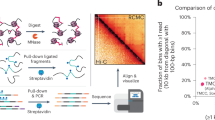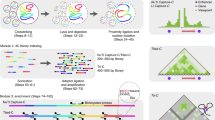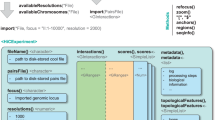Abstract
The spatial organization of DNA in the cell nucleus is an emerging key contributor to genomic function1,2,3,4,5,6,7,8,9,10,11,12. We developed 4C technology (chromosome conformation capture (3C)-on-chip), which allows for an unbiased genome-wide search for DNA loci that contact a given locus in the nuclear space. We demonstrate here that active and inactive genes are engaged in many long-range intrachromosomal interactions and can also form interchromosomal contacts. The active β-globin locus in fetal liver preferentially contacts transcribed, but not necessarily tissue-specific, loci elsewhere on chromosome 7, whereas the inactive locus in fetal brain contacts different transcriptionally silent loci. A housekeeping gene in a gene-dense region on chromosome 8 forms long-range contacts predominantly with other active gene clusters, both in cis and in trans, and many of these intra- and interchromosomal interactions are conserved between the tissues analyzed. Our data demonstrate that chromosomes fold into areas of active chromatin and areas of inactive chromatin and establish 4C technology as a powerful tool to study nuclear architecture.
This is a preview of subscription content, access via your institution
Access options
Subscribe to this journal
Receive 12 print issues and online access
$209.00 per year
only $17.42 per issue
Buy this article
- Purchase on Springer Link
- Instant access to full article PDF
Prices may be subject to local taxes which are calculated during checkout






Similar content being viewed by others
Accession codes
References
Misteli, T. Concepts in nuclear architecture. Bioessays 27, 477–487 (2005).
Sproul, D., Gilbert, N. & Bickmore, W.A. The role of chromatin structure in regulating the expression of clustered genes. Nat. Rev. Genet. 6, 775–781 (2005).
Chakalova, L., Debrand, E., Mitchell, J.A., Osborne, C.S. & Fraser, P. Replication and transcription: shaping the landscape of the genome. Nat. Rev. Genet. 6, 669–677 (2005).
Volpi, E.V. et al. Large-scale chromatin organization of the major histocompatibility complex and other regions of human chromosome 6 and its response to interferon in interphase nuclei. J. Cell Sci. 113, 1565–1576 (2000).
Chambeyron, S. & Bickmore, W.A. Chromatin decondensation and nuclear reorganization of the HoxB locus upon induction of transcription. Genes Dev. 18, 1119–1130 (2004).
Brown, K.E. et al. Association of transcriptionally silent genes with Ikaros complexes at centromeric heterochromatin. Cell 91, 845–854 (1997).
Grogan, J.L. et al. Early transcription and silencing of cytokine genes underlie polarization of T helper cell subsets. Immunity 14, 205–215 (2001).
Osborne, C.S. et al. Active genes dynamically colocalize to shared sites of ongoing transcription. Nat. Genet. 36, 1065–1071 (2004).
Spilianakis, C.G., Lalioti, M.D., Town, T., Lee, G.R. & Flavell, R.A. Interchromosomal associations between alternatively expressed loci. Nature 435, 637–645 (2005).
Branco, M.R. & Pombo, A. Intermingling of chromosome territories in interphase suggests role in translocations and transcription-dependent associations. PLoS Biol. 4, e138 (2006).
Roix, J.J., McQueen, P.G., Munson, P.J., Parada, L.A. & Misteli, T. Spatial proximity of translocation-prone gene loci in human lymphomas. Nat. Genet. 34, 287–291 (2003).
Lemaitre, J.M., Danis, E., Pasero, P., Vassetzky, Y. & Mechali, M. Mitotic remodeling of the replicon and chromosome structure. Cell 123, 787–801 (2005).
Dekker, J., Rippe, K., Dekker, M. & Kleckner, N. Capturing chromosome conformation. Science 295, 1306–1311 (2002).
Lomvardas, S. et al. Interchromosomal interactions and olfactory receptor choice. Cell 126, 403–413 (2006).
Brown, J.M. et al. Coregulated human globin genes are frequently in spatial proximity when active. J. Cell Biol. 172, 177–187 (2006).
Splinter, E., Grosveld, F. & de Laat, W. 3C technology: analyzing the spatial organization of genomic loci in vivo. Methods Enzymol. 375, 493–507 (2004).
Rippe, K., von Hippel, P.H. & Langowski, J. Action at a distance: DNA-looping and initiation of transcription. Trends Biochem. Sci. 20, 500–506 (1995).
Ling, J.Q. et al. CTCF mediates interchromosomal colocalization between Igf2/H19 and Wsb1/Nf1. Science 312, 207–208 (2006).
Wurtele, H. & Chartrand, P. Genome-wide scanning of HoxB1-associated loci in mouse ES cells using an open-ended chromosome conformation capture methodology. Chromosome Res. 14, 477–495 (2006).
Jurka, J. et al. Repbase Update, a database of eukaryotic repetitive elements. Cytogenet. Genome Res. 110, 462–467 (2005).
Zhang, Z., Schwartz, S., Wagner, L. & Miller, W. A greedy algorithm for aligning DNA sequences. J. Comput. Biol. 7, 203–214 (2000).
Sokal, R.R. & Rohlf, F.J. Biometry: the Principles and Practice of Statistics in Biological Research 3rd edn. (W.H. Freeman, New York, 1995).
Acknowledgements
We thank F. Grosveld for support and discussion and S. van Baal, M. Branco, A. Pombo, P. Verrijzer, J. Hou, B. Eussen, A. de Klein, T. de Vries Lentsch, D. Noordermeer and R.-J. Palstra for assistance. This work was supported by grants from the Dutch Scientific Organization (NWO) (912-04-082) and the Netherlands Genomics Initiative (050-71-324) to W.L.
Author information
Authors and Affiliations
Contributions
M.S. set up, performed and analyzed 4C experiments and wrote the paper; P.K. performed cryo-FISH experiments; E.S. helped set up 4C; Y.M. helped with statistical analysis; R.W. prepared cryosections; E.d.W. and B.v.S. provided probe sequences and helped with statistical analysis and W.d.L. designed experiments and wrote the paper.
Corresponding author
Ethics declarations
Competing interests
The authors declare no competing financial interests.
Supplementary information
Supplementary Fig. 1
4C analysis of HS2 and Hbb-b1 give highly similar results. (PDF 111 kb)
Supplementary Fig. 2
4C detects interactions previously identified by FISH. (PDF 85 kb)
Supplementary Fig. 3
Regions that interact with β-globin also frequently contact each other. (PDF 32 kb)
Supplementary Fig. 4
Rad23a colocalizes with gene-dense regions in cis. (PDF 48 kb)
Supplementary Table 1
Intrachromosomal interactions detected by 4C. (PDF 61 kb)
Supplementary Table 2
Overview of cryo-FISH results for intrachromosomal interactions. (PDF 16 kb)
Supplementary Table 3
Cryo-FISH results for interchromosomal interactions. (PDF 39 kb)
Supplementary Table 4
Interchromosomal interactions with Rad23a detected by 4C. (PDF 36 kb)
Supplementary Table 5
Primer sequences used for 4C analysis. (PDF 16 kb)
Rights and permissions
About this article
Cite this article
Simonis, M., Klous, P., Splinter, E. et al. Nuclear organization of active and inactive chromatin domains uncovered by chromosome conformation capture–on-chip (4C). Nat Genet 38, 1348–1354 (2006). https://doi.org/10.1038/ng1896
Received:
Accepted:
Published:
Issue Date:
DOI: https://doi.org/10.1038/ng1896
This article is cited by
-
Determination of DNA architecture of bacteria under various types of stress, methodological approaches, problems, and solutions
Biophysical Reviews (2023)
-
HiCmapTools: a tool to access HiC contact maps
BMC Bioinformatics (2022)
-
Mapping transgene insertion sites reveals the α-Cre transgene expression in both developing retina and olfactory neurons
Communications Biology (2022)
-
Chemically Induced Chromosomal Interaction (CICI) method to study chromosome dynamics and its biological roles
Nature Communications (2022)
-
Hodge theory-based biomolecular data analysis
Scientific Reports (2022)



